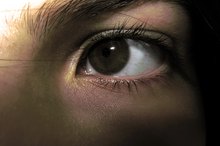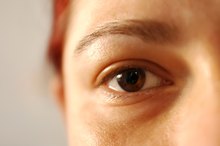Can You Exercise With an Eye Infection?
Eye infections are commonly referred to as "pink eye" but the correct term is conjunctivitis. Simply, conjunctivitis means inflammation of the conjunctiva, or white part of the eye.
There are three main types of conjunctivitis: viral, bacterial and allergic. It is important to identify which type you have in order to know if exercising while you have the infection is advised.
Viral Conjunctivits
Viral conjunctivitis is the most common form of conjunctivitis in adults. The symptoms of viral conjunctivitis are tearing, redness, mild burning and some swelling of the eyelids.
The infection is caused by coming into contact with a virus, often a cold virus. It can be transferred from the hands to the eye or through respiratory droplets in the air. The infection can last from four to seven days.
There are no anti-viral eye drops available for this type of infection.
Exercising while you have this infection will not make the infection any better or any worse. However, you are highly contagious, so avoid going to the gym or exercising in public places. Wipe down everything you come into contact with so as not to spread the infection to others.
- Viral conjunctivitis is the most common form of conjunctivitis in adults.
- There are no anti-viral eye drops available for this type of infection.
Bacterial Conjunctivitis
Treatment for an Eye Cold
Learn More
Bacterial conjunctivitis is more common in children and in adults that care for children. This infection is typically painless. It causes redness, matter and mucous discharge. You may have a concurrent upper respiratory tract infection or ear infection.
There are anti-bacterial drops that can be taken to lessen the duration and intensity of the infection. Exercise is okay during this infection, but again, you are contagious so avoid public places. Remember good hand washing and avoid unnecessary exposure to other people. If your bacterial conjunctivitis is accompanied by an upper respiratory infection, talk to your doctor before engaging in strenuous exercise.
- Bacterial conjunctivitis is more common in children and in adults that care for children.
Allergic Conjunctivitis
Allergic conjunctivitis is characterized by itching, red, watering eyes. It is almost always bilateral. There are several treatments for allergic conjunctivitis, both over-the-counter and prescription. Allergic conjunctivitis is generally seasonal.
This is the one type of conjunctivitis that will be made worse by exercising. One reason is when you exercise your blood vessels dilate, allowing more histamine to be released, which causes an increase in the sensation of itching. In addition, you may inadvertently be exposing yourself to the allergens that are causing the problem in the first place. For example, a runner who always runs by a beautiful golden meadow in the spring may be exposing himself to an allergen every time he passes by. So hold off on the exercise until your symptoms can be controlled with medication. This type of conjunctivitis is not contagious.
- Allergic conjunctivitis is characterized by itching, red, watering eyes.
- This is the one type of conjunctivitis that will be made worse by exercising.
Treatments
Lemon Juice for Pink Eye
Learn More
There are no curative treatments for viral conjunctivitis; however, your eye care professional may prescribe eye drops for you to either make the symptoms more tolerable or to prevent a secondary bacterial infection. There are many types of eye medications available to treat bacterial conjunctivitis. These are all available as prescription only. Depending on your symptoms and the appearance of your eyes, the doctor will prescribe the appropriate antibiotic drop.
A bacterial eye infection will usually self-limit in seven days, even if no eye drops are taken. Allergic conjunctivitis can have the longest duration because it is seasonal. As long as you are being exposed to the particular allergens that you are sensitive to, your eyes can continue to react. Luckily, there are many over-the-counter and prescription drops available to treat the symptoms. Also, never underestimate the value of a cold compress in an allergic conjunctivitis flare-up.
- There are no curative treatments for viral conjunctivitis; however, your eye care professional may prescribe eye drops for you to either make the symptoms more tolerable or to prevent a secondary bacterial infection.
Related Articles
References
- "Primary Care of the Anteria Segment"; Louis J Catania; 1996
- "The Wills Eye Manual"; Rhee, Douglas J and Mark F. Pyfer; 1999
- Handbook of Ocular Disease/ Allergic Conjunctivitis
- Centers for Disease Control and Prevention. Conjunctivitis (Pink Eye): Causes. Updated January 4, 2019.
- Meyer-rüsenberg B, Loderstädt U, Richard G, Kaulfers PM, Gesser C. Epidemic keratoconjunctivitis: the current situation and recommendations for prevention and treatment. Dtsch Arztebl Int. 2011;108(27):475-80. doi:10.3238/arztebl.2011.0475
- National Eye Institute. Facts About Pink Eye. Updated November 2015.
- Azher, T.; Yin, X.; Tajfirouz, D. et al. Herpes simplex keratitis: challenges in diagnosis and clinical management. Clin Ophthalmol. 2017; 11:185-91. doi:10.2147/OPTH.S80475
- Goodman, D.; Rogers, J.; and Livingston, E. Conjunctivitis. JAMA. 2013; 309(20):2176. doi:10.1001/jama.2013.4432
- Palafox S.; Jasper, S.; Tauber, A. et al. Ophthalmia Neonatorum. J Clinic Experiment Ophthalmol. 2011; 2:119. doiI:10.4172/2155-9570.1000119.
- National Eye Institute. Cornea | Giant Papillary Conjunctivitis (GPC).
- Zikic A, Schünemann H, Wi T, Lincetto O, Broutet N, Santesso N. Treatment of Neonatal Chlamydial Conjunctivitis: A Systematic Review and Meta-analysis. J Pediatric Infect Dis Soc. 2018;7(3):e107-e115. doi:10.1093/jpids/piy060
Writer Bio
Tonya Edwards began writing professionally in 2011 for various websites. She is currently an optometrist and lives in Michigan. Edwards holds a Bachelor of Science in biology from South Dakota State University with minors in Spanish and chemistry. She has a doctorate from the Michigan College of Optometry.








